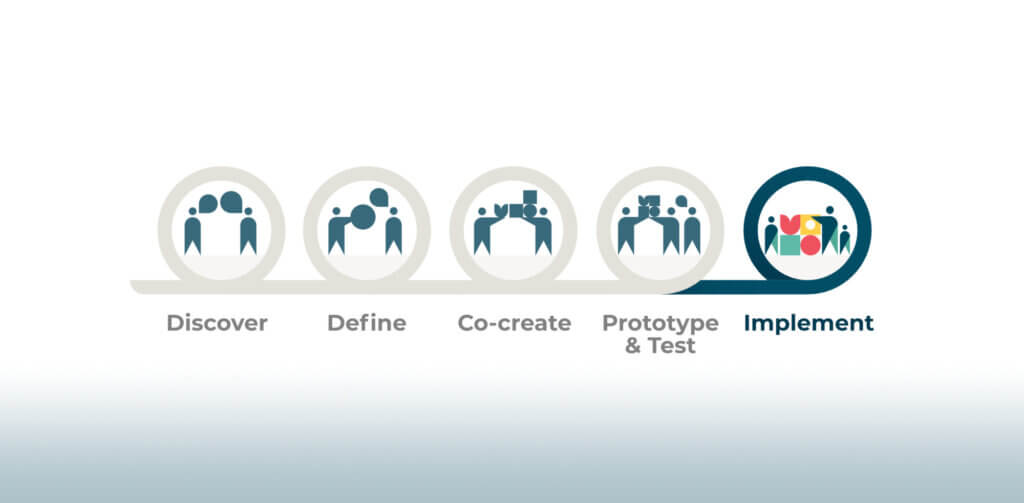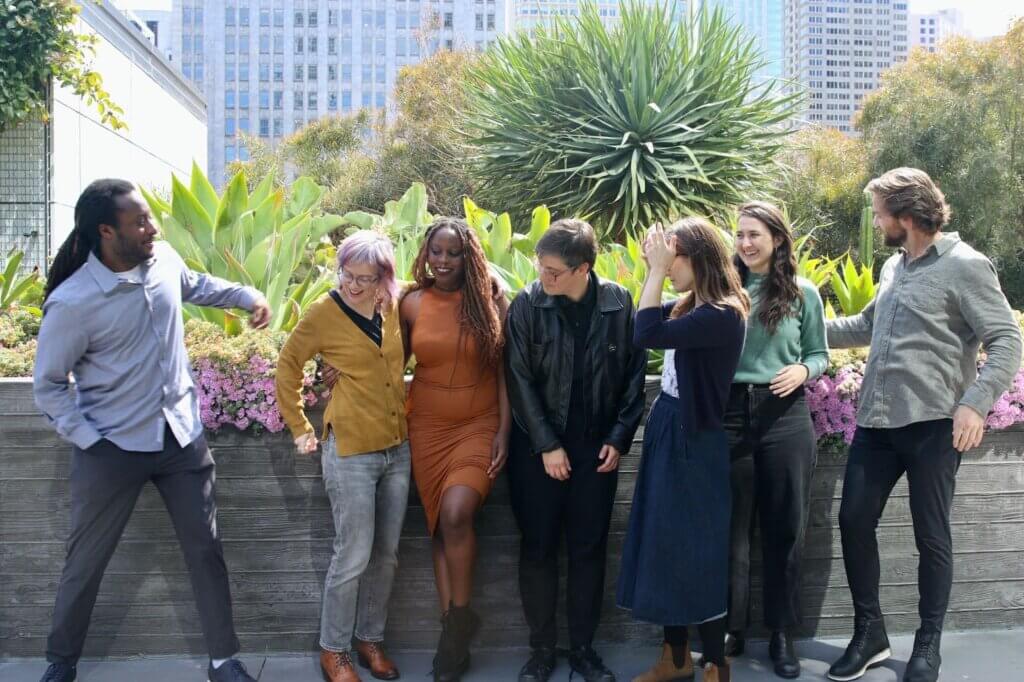Trusting the process, and the people — Designing the Parks and Tech Challenge

Oftentimes, when deep into the design of a group process, I hit a point where the possibility of failure seems all too real, and that no amount of preparation will save an event destined not to make an impact. At times like these, I try to take a deep breath and repeat the facilitator’s mantra of “trust the process.” Preparations for The Parks and Tech Challenge were no different, but after months of active listening, careful planning and a fair amount of fretting, the event exceeded my expectations for energy, community and some solid solutions to upgrade our National Parks. And I learned once again, it’s as much about the people in the room as it is about the process.
Deferred What, Now?
So what was the Parks and Tech Challenge? The Pew Charitable Trust asked us to host a hackathon to come up with some creative ideas for using technology to address the National Park Service’s (NPS) $11 billion “deferred maintenance” backlog of repairs to facilities, trails, and infrastructure. Pew’s Restore America’s Parks campaign has long advocated the need for Congress to allocate additional funding to address this compounding budget item, but with our parks dangling in the political wind, they want to present some fresh ideas.
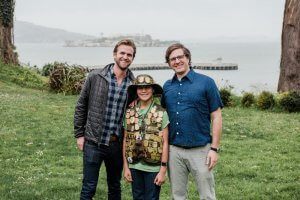
At CivicMakers, we thrive at the intersection of technology, community and public service, and we love leveraging collective expertise to develop collaborative community-driven solutions to complex challenges. So this was exactly our kind of challenge. Along with longtime Pew consultant Sean Watson, we dove into designing a weekend-long event that would harness the passion and expertise of technologists, designers, entrepreneurs and park experts to develop creative solutions that use technology to help Parks Service staff improve the management and maintenance of our National Parks. In the end, it was a super fun, action-packed weekend at the stunning General’s Residence in San Francisco, with 9 teams receiving guidance from experienced NPS leaders and pitching their ideas to a panel of judges that included former National Park Service Director Jon Jarvis and other leading experts on parks and technology.
But what was our process to get there? Let’s dive in.
Discovering Deferred Maintenance
Let’s not kid ourselves, the NPS deferred maintenance backlog is not a sexy topic for a hackathon. As one of our mentors, former NPS Staffer Tim Harvey told us, “in 2001 NPS adopted industry standard asset life cycle business practices as well as an enterprise asset management system for the management of its unique portfolio of constructed assets.” Say that ten times fast! From asset priority index to condition assessments, this topic for a hackathon required some careful framing.
Of course, people love our national parks, but not many understand the mountains of expensive maintenance that put the structural integrity and safety of our parks at risk. And this was the crux of designing this event — how might we take such a wonkish topic and convey the specifics to teams in enough detail that they could develop a meaningful solution in 36 hours? The answer, of course, was to empathize.
CivicMakers starts every project with a robust discovery phase because we know context and empathy is so important for achieving real outcomes and impact. To steep ourselves in the context of deferred maintenance, we sought out experts in the field to serve as our core stakeholders. We interviewed a dozen active and retired NPS staff, from former NPS Director Jon Jarvis to facility managers and superintendents across the country in National Parks like Blue Ridge National Parkway, Sequoia and Kings Canyon, Fire Island National Seashore, Yellowstone and Golden Gate National Recreation Area. Listening to the stories and challenges of these public servants was endlessly inspiring, and gave us a very good contour of the challenges they faced. During this process, we also met our Challenge Mentors, Tim Harvey, Steve Iobst and Phil Selleck, all career parks professionals with a combined 100+ years in the Service.
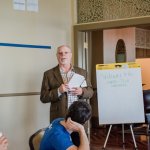

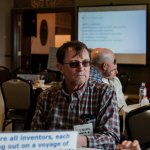
This discovery phase ended in a group of Challenge Areas, originally encompassing data, visitor experience, communications and partnerships, each with specific Challenge Statements. With the help of these stakeholders, our mentors and the Restore America’s Parks team at Pew, we continued to refine these Challenge Statements, eventually whittling them down to two areas: “Harnessing the Power of Data” and “Improving the Visitor Experience.” With refined and validated Challenge Statements, we leaned on our Mentors to start compiling background that we could share with participants, including this video call.
Designing for Deferred maintenance
With this background at the ready, we began conceiving of a flow for the weekend with a few Design Principles:
- We are not experts — let the experts guide teams
- Trust the people in the room — let them help guide the flow of the weekend
- Provide a structure to create understanding and accountability, but be flexible
- Focus on community and creating bonds among participants
- Parks are fun and safe, this event should be too
After much back and forth, plenty of consultation with colleagues and many a whiteboard session, here’s the overall event design we came up with:
- Develop context — We started Saturday morning out first as a full group learning about deferred maintenance from Marcia Argust, Director of Pews’ Restore America’s Parks campaign. To quickly get folks on the same page with a central collaboration point, we shared a “Trailhead” document with info, resources and all the data we could offer. It was a bright, beautiful day in GGNRA, so the piercing fire alarm that shocked us all was actually a welcome opportunity to get outside. We knew we were competing with a glorious San Francisco winter day, so we promptly had participants select the data or visitor experience group, then took them outside again for some bonding over a get-to-know-you exercise. Afterwards both groups heard deep dives about each challenge, with plenty of time for Q&A and inspiring projects from the good folks at Mapbox.
- Synthesize “current state” challenges, dream ideal “future states,” then ideate solutions to get from here to there — We wanted to get teams working together as quickly as possible, so what better way to ensure everyone’s voice is heard than with post-it notes! We chose current state/future state to encourage grounding solutions in real problems, but also thinking big. It worked. Teams came up with some stellar ideas that they began to rally around.
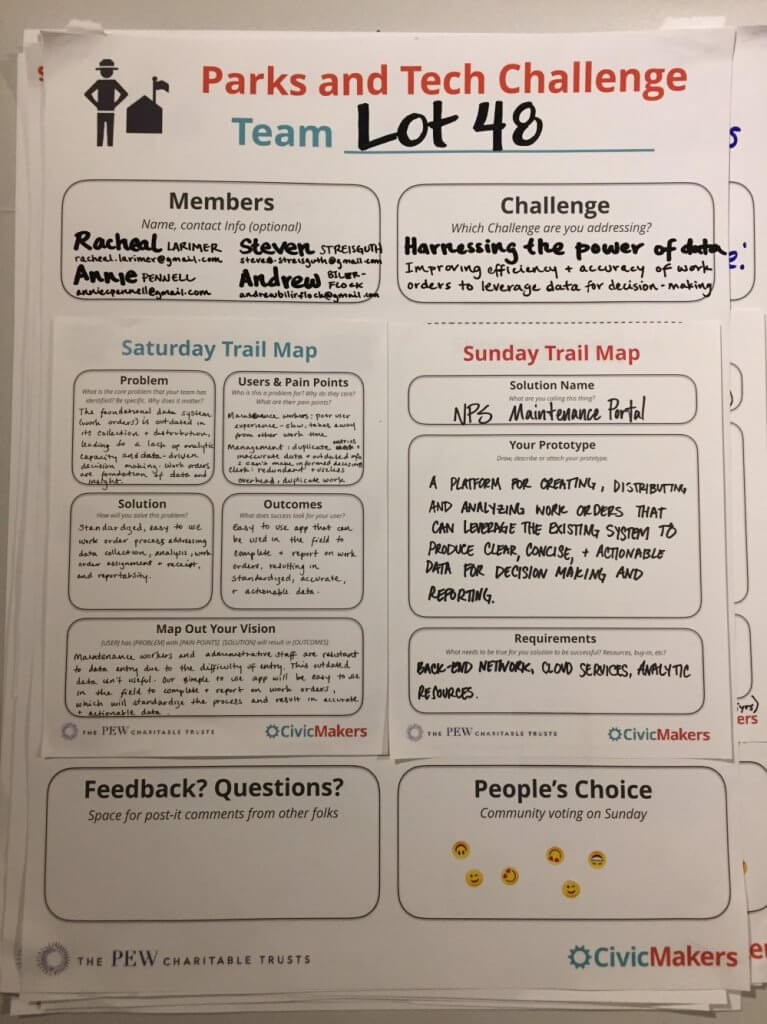
The Parks and Tech Trail Map - Form teams and hit the trail! — This was probably the moment that made us most nervous in our planning — how would teams form around ideas? In the end, with help from some talented co-facilitators, we nudged participants into teams that felt a shared purpose and commitment to collaboratively address their challenge. With a tasty box lunch from Town Kitchen in hand, teams were off! To keep them focussed over the course of the weekend, we created a “Trailmap,” a set of worksheets that together made team posters, which doubled as a helpful gallery to guide latecomers to teams.
- Regular check ins with parks Mentors — Throughout the course of the weekend, we strongly encouraged teams to leverage the insight of our Mentors, as well as the Restore America’s Parks team, to answer questions and guide the development of their solutions. There was some uncertainty from three former NPS staffers who had never been to a hackathon before, but they couldn’t have been more game. It was incredibly fulfilling to see the exchange between career NPSer’s and parks lovers eager to help.
- Pitch ideas — Finally, we made it clear to teams from the beginning that their goal for the weekend was ultimately to pitch their idea to our panel of judges. Many teams went way beyond with working prototypes of immersive digital experiences, voice-to-text services and geolocation-enabled data collection apps. In the end, 9 teams arrived and 9 teams presented detailed, carefully considered ideas — success by any measure.

Cultivating Community to Address Deferred Maintenance
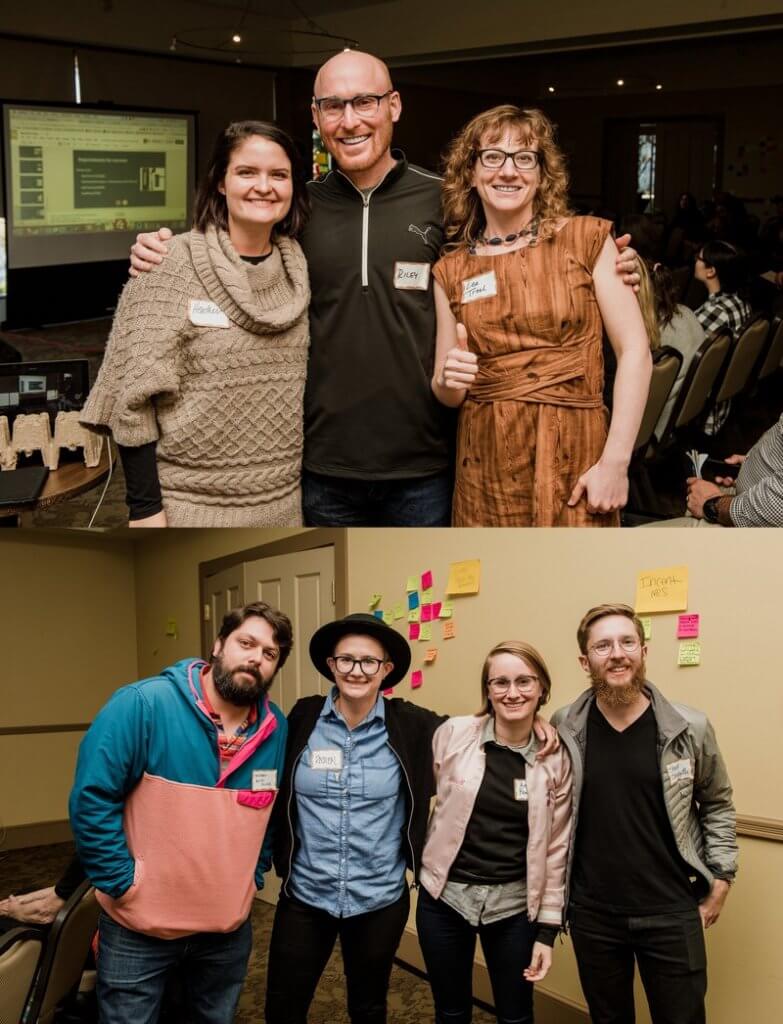
In the end, we had great solutions. The winning team “Petrified Olympic Voyageurs” presented “MyNPS,” a “FastPass for National Parks” app and loyalty program that would reduce staff needed at park entrances, increase opportunities to collect fee revenues, allow for the delivery of other services, and enable visitors to donate easily. The runner-up “Lot 48” proposed a revamped work order system to increase the amount of deferred maintenance data captured in the field through a streamlined user interface that leverages mobile photos. Both solid, well-executed ideas that squarely addressed the topic of deferred maintenance.
Beyond the solutions presented, we also had civilians talking deferred maintenance lingo within 36 hours, despite having neverknown about the issue prior to the event. For a critical issue facing a beloved public resource that has zero public awareness, each of these participants is now an ambassador for life. What’s more, we had incredible partners from the National Park Foundation, National Trust for Historic Preservation, National Park Trust and more all inspired by some new ideas and talking about the issue together. To boot, we even had some press coverage.
But most importantly, I think, were the real bonds formed between everyone who committed to spending their weekend together because of their shared love for our National Parks, and desire to apply their own unique skills and experiences to solving this problem. The rapport between participants, mentors, judges and hosts was honest, excited and downright fun. That was the key factor that drove 9 teams from Saturday morning all the way through to Sunday night with no drop-off.
As a humble facilitator, I couldn’t be more proud. And I’m reminded that not only do you need to trust the process, you have to trust the people, too.
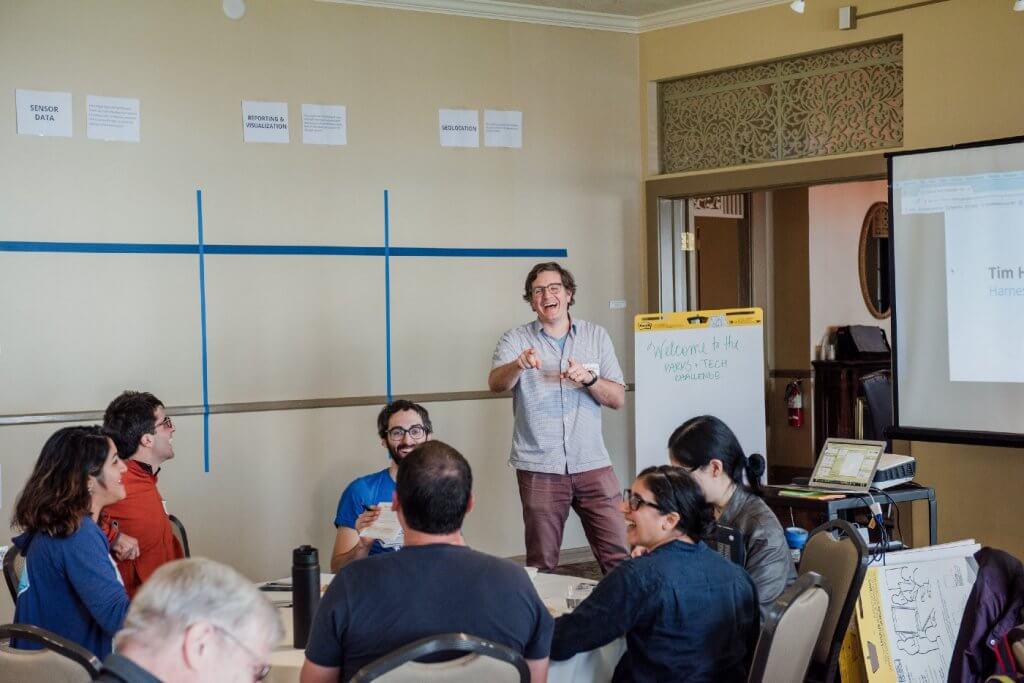
—
Sincere thanks to The Pew Charitable Trusts for making this weekend possible and trusting CivicMakers to deliver.
We are very grateful for the participation of our Technology Partner Mapbox, a platform for developers and designers to build experiences for exploring the world.
A huge round of applause for our Mentors Tim Harvey, Phil Selleck and Steve Iobst, without whom we would have just been making stuff up.
A very special thank you to the amazing Mitali Chakraborty for saving us in the 11th hour by making sure the trains ran on time and that everyone and everything was cared for 🙂
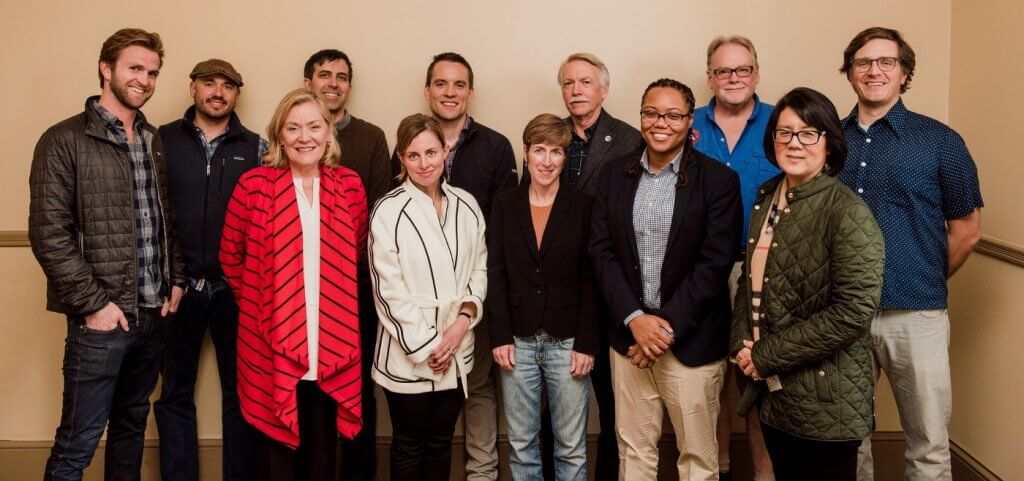
Finally, a big thank you as well as to our panel of judges which included: Jon Jarvis, former Director of National Park Service; Marcia Argust, Project Director for Restore America’s Parks at The Pew Charitable Trusts; Monica Rhodes, Associate Director of HOPE Crew at the National Trust for Historic Preservation; Grace Lee, Executive Director at the National Park Trust; Kateri Callahan, President at the Alliance to Save Energy; Matt Provost, Vice President of Strategic Partnerships at the National Park Foundation; Ryan Branciforte, CEO of Trailhead Labs; Chris McLaughlin, VP of Product and Data Insights at Munchery, Jonathan Knowles, Head of Faculty at Singularity University; and Michelle Lane, Professional Staff Member of the U.S. Senate Energy and Natural Resources Committee.
Let’s do this again!
